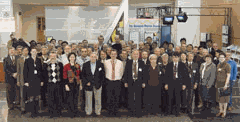The 2008 Three-Way Meeting (3WM) between the European Synchrotron Radiation Facility (ESRF), the Super Photon Ring-8 GeV (SPring-8), and the Advanced Photon Source (APS) was held at Argonne on March 18-19, 2008, with more than 20 representatives from each facility. Topics discussed at the meeting included the facility directors' visions, machine operations and stability updates, accelerator research and development plans, beamline strategic planning, highlights in x-ray science and techniques, beamline enablers, and links with agencies and regions. Satellite workshops were held on March 17 on the topics “X-ray Optics,” “Nanoscience with X-rays,” and “User Services,” and on March 19 on “Accelerator R&D.” Organizers of this year’s meeting were Katherine Harkay (Argonne-ASD), Fabio Comin (ESRF), and Yoshiharu Sakurai (SPring-8).
Both the 3WM and satellite workshops served as platforms for presentation and discussion of new and exciting developments that will positively impact the synchrotron radiation community well into the future and foster opportunities for collaboration among the three facilities.
The main meeting opened on March 18 with a welcome by Argonne Director Robert Rosner. He was followed by ESRF Director General William Stirling, who spoke on the current status of both the ESRF and the proposed upgrade program. Next, SPring-8 Director General Akira Kira delved into the “Socialization of SPring-8,” followed by APS Director Murray Gibson on planning for the “APS Renewal.” Of particular interest in the discussions were the upgrade plans being proposed by each of the facilities. While different in detail, all three respond to the same science drivers – basically the realm of the ultra-small (<1 nm) and the ultra-fast (<1 ps).
There followed two very full days of presentations on topics of mutual interest to the three facilities. In the 3WM tradition, the directors’ talks were followed by status reports on accelerator operation and stability and on future accelerator development. The rest of the meeting focused on beamlines and x-ray science, beginning with beamline strategic planning and including a discussion of scientific and economic regional links and discussions of beamline enablers, including optics, detector development, and scientific data handling, with an emphasis on macromolecular crystallography.
Highlights of the meeting were presentations of exciting new scientific developments in nanoscience using x-rays, science with high-energy x-rays, dynamical single molecular observations of functional membrane proteins, polarization-dependent soft x-ray studies, advances in magnetism and soft condensed matter, and time-resolved science.
During the final session, the three directors reiterated the value of the 3WM and their support for future meetings. Interested visitors stayed on to participate in tours of the beamlines and the accelerator areas.

